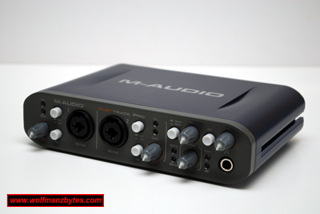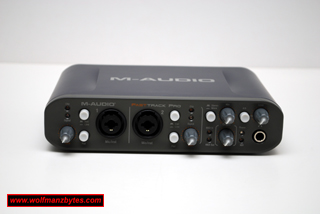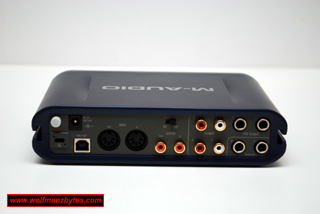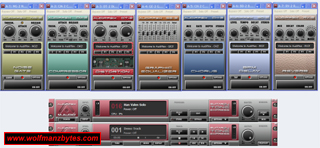
See the Video version of this Review here..
Today I take a look at the M-Audio Fast Track Pro that I purchased when I started doing the latest batch of Youtube Videos.
Before I get into this Review I want to mention the specs of the M-audio Fast Track Pro.
-insert jack (¼” TRS) for outboard processors
-2 balanced outputs (¼” TRS)
-4 unbalanced outputs (RCA)
-S/PDIF digital I/O with w/ 2-channel PCM
-S/PDIF out also supports pass-through of AC-3/DTS surround-encoded content
-1 x 1 MIDI I/O with activity LEDs
-headphone output (¼” TRS) with level control
-headphone A/B source switch for DJ-style cueing
-input/playback mix control for hardware direct monitoring
-mono switch for input/playback direct monitoring
-master output level control
-near zero-latency hardware direct monitoring
-low-latency ASIO software monitoring
-USB connection to computer
-powered via USB or optional AC power adapter
-Kensington lock port
-Mac and PC compatible; class compliant with Mac OS X 10.3.9 and higher
-includes Ableton Live Lite music production software so you can make music right away
-* 16-bit/48kHz 2 x 4 operation is class-compliant. Driver installation required to access more I/O.
When I first started doing the Youtube video reviews I wasn’t that happy with sound quality of the built in mic on the Panasonic video camera I had. What really annoyed me to know end was the fact the camera didn’t have a line in or a mic in where I could replace the internal mic with a good external mic and fix the sound quality problem once and for all. One way I addressed this early on was to record a second audio track onto the computer and then replace the audio track of the video camera with the recorded computer track that was done with a good mic.
As time went on I found that I needed more space to do the video Reviews and this brought up another issue and that was if I was going to shoot the video in another room I would need something portable to record the audio track. I was also thinking at this time that I needed a laptop so I could make sure I stay on track and keep certain product points on a screen where I could see it while recording the video reviews.
A while back my brother bought an M-audio Fast Track Pro for his apple laptop and I got chance to play around with that for a bit and so when I needed an audio interface for my laptop I decided to purchase the M-audio Fast Track Pro as well. The other key feature I liked with the M-audio Fast Track Pro is it has Phantom power and this was something I was going to need for a couple of mics I wanted to use for doing the video reviews.
So fast forward a few weeks and I have been using the M-Audio Fast Track Pro a fair bit. For the most part this interface will do what I want with no issues at all after all I’m just trying to get a simple audio track recorded at 48 khz to match the camera audio track and the M-audio Fast Track Pro does that no problem at all. When you look at the picture below you can see the controls for the fast track pro and for the most part they are easy to figure out.
From left to right you see you have you 2 inputs and these are dual inputs in that they can handle quarter inch plugs or XLR plugs. Each front input has an insert / line switch as well and you will have that set depending on what you have inserted into the input. You also have two lights on each input to tell you if you’re getting a signal into that input and also a light to tell you if you’re clipping the input, as in your input level is too high. Each input also has its own input volume selector where you can control how much input comes into the fast track pro. Each input also has a pad switch which will cut / reduce the signal down if it’s too hot for the input.
Continuing with the front controls you will also see a mono or a stereo button along with a mix level and an output level. There are also two lights that will tell you if you have midi coming in or going out of the Fast Track Pro. The next thing you will see will be the A/B selector and right beside that you have the headphone volume. Under the Headphone volume knob is the headphone jack along with two lights. The one light is to tell you if the power is on to the Fast Track Pro. The second light tells you if you have the Phantom power on or off and you can turn that on or off via a switch on the back of the Fast Track Pro.
In the picture below you can see the back side of the Fast Track Pro and the various connections you have. Again from left to right you have the power switch along with the kensington lock port. Next up you see the power connector and the USB connector. The Fast Track Pro does not come with a power adapter and the reason for that is it will run off the power of a USB port. If for some reason you wanted to run the fast track pro off a power adapter you have to purchase that separately.
The next set of hookups you see are for the midi in and out. Beside midi jacks you also have S/PDIF in and out and above that you see the 48 Volt Phantom power on and off switch. The next set of 4 RCA jacks are all output jacks for the various inputs. Beside the RCA jacks you see the quarter inch inserts and outputs. You can use the insert and output jacks to hook up things like an effects processor to the inputs that you see on the front of the Fast Track Pro or the use the outputs to go direct to a mixer.
Now onto the included software, normally when you get software with a product like this the software is either no good or just on the verge of being no good. I decided once I had the fast track pro working to test out the pro tools software that come with the Fast Track Pro just to see what the software was like. To make a long story short pro tools stayed on my computer for about a total of 5 minutes. The reason I removed it so fast was how they crippled it and it was in the form of not being able to save any of your work. For the life of me I don’t know what the people at M-audio are thinking about when they include software like this. When you get into a program like pro tools it’s so powerful and complicated that it will take weeks of messing around with it to get a good feel of how it works. The very fact I can’t save any of my work and I have to start over each time I reload the software is just pure craziness. Why M-audio doesn’t give its users something useful to use is beyond me. How much would it cost M-Audio to include an out dated version of Cubase version 4? Sure the software is old and maybe not even supported by Steinberg but the fact remains that at least it’s a very useable multi track sound editor that you can do stuff with.
Where I did get some joy from the included software was from a program called Intone Express that’s made by Audiffex. I went onto the M-audio web site and downloaded the latest version of this software and despite the fact it’s not as good as the pro version of Intone that you have to buy I was still impressed with it. Below you can see a screen shot of the guitar pedals that you can use with Intone Express.
What blew me away about Intone express was the sound of it and how many different sounds you can get with it. Just like real hardware based foot pedals this thing allows you to hook up a bunch of different foot pedals together like a distortion pedal and a reverb pedal and you can tweak the sounds all night long. When I was using the Intone software I was using a cheap acoustic guitar with a bridge pickup and was shocked at the sounds I could get. In fact I was so shocked with how good these effects were that I went out and bought a Fender American Standard Telecaster a couple of days latter so I could hear these effects on a good electric guitar and man am I impressed. I had been thinking about picking up a Telecaster for a few years now but just never got around to it until I started messing around with this software and that’s was when I made up my mind to buy one. My fingers on my right hand got torn up badly from the 9 hour guitar sessions that I was doing with the new telecaster and the Intone express effect pedals but man was it fun.
The other cool thing about the Intone express software is that you can record what you’re playing then play that back and jam along with it. You can also load audio tracks in both mp3 and wav format and jam along with that. The player can also loop your audio tracks and even change the speed at which they play.
One thing I would like to see changed is for Intone express to just have one screen and all the guitar pedals get placed on that one screen. Right now when you start Intone express up it just loads right up onto your screen and programs in the background can still be seen. To me it would be cleaner looking to just be looking at Intone express and nothing else on my screen.
The only other thing I would have liked to have seen in this version of Intone express is a guitar tuner built into the software and maybe even a metronome. Other then these small complaints I’m super impressed with this program. It should be noted that you can upgrade to the pro version of the software for about $69.00 U.S and that gives you even more pedals and a guitar tuner along with more options as well. There is also Intone software for bass and keyboards that comes free when you get the M-Audio Fast Track Pro and these can be upgraded to the pro version as well for the $69.00 U.S.
Now onto the bad parts of the M-Audio Fast Track Pro and there are really only two. The first problem I ran into was with the preamps built into the fast track pro they are simply way to weak. Anything I plug into this thing whether it is guitar or mics all require you to turn the input volume to about 9 out of 10 in order to get any decent audio level. You also have to have the headphone volume at 10.
The next problem I see with the fast track was no doubt done on purpose from M-Audio and that is if you want to record at 24 bit 96khz you can only do so one input at a time unless you’re using the S/PDIF input. You can’t even have an output selected to have the mix come back through the headphones. The reason for this is the USB 1.1 speed simply isn’t fast enough to be able to deal with multiple audio streams running at 24 bit 96khz. For me this isn’t going to be a problem but it’s something you may want to keep in mind if you plan on using both inputs on the front of the fast track pro and plan on recording at 24 bit 96khz. It would have been nice if M-Audio would have made this a USB 2.0 device then there would be no problem at all doing 24 bit 96khz on multiple inputs and outputs.
In conclusion overall I’m pretty impressed with M-audio Fast Track Pro. Since I have been messing around with it I haven’t noticed any latency issues at all and I’m surprised by that considering it’s a USB device. As I mentioned above I think the fast track pro needs much better preamps and I would also like to see some decent multi track audio software even if it’s a few years old. For those looking for an Interface they can just plug in and record and are not concerned about 24 bit 96khz then this will no doubt be a good choice. At the time of this Review you could purchase the M-Audio Fast Tack Pro for about $220.00 Canadian.
If you would like more information on the M-Audio Fast Track Pro you can go to their web site here.
WolfManz611..




